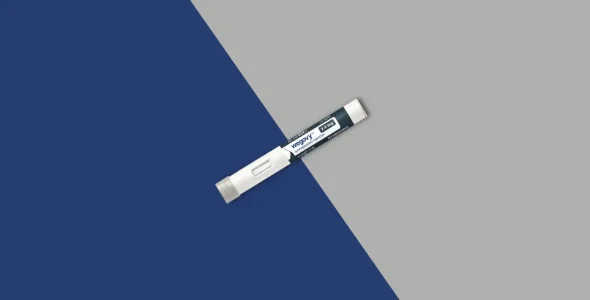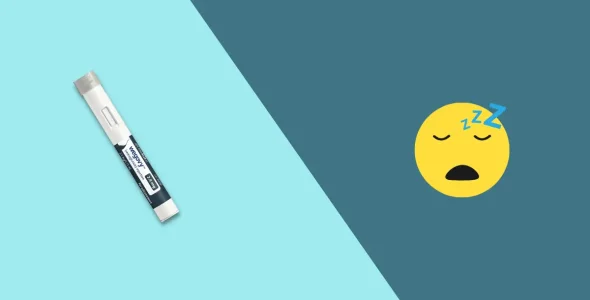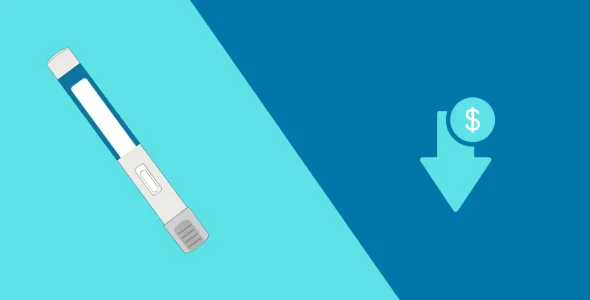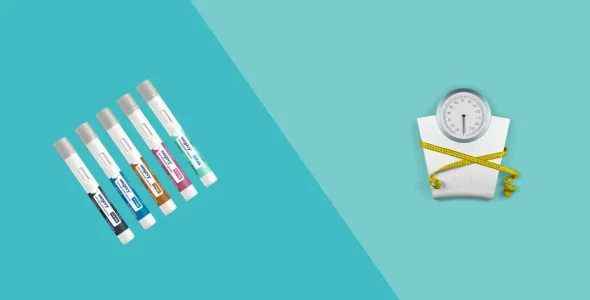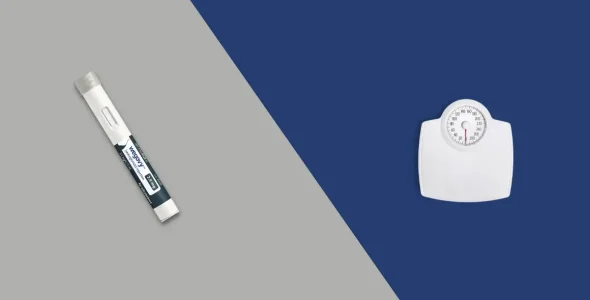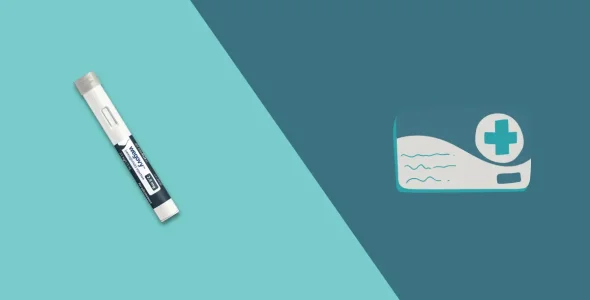Wegovy dosage chart for weight loss: Dose schedule and optimization tips
Wegovy, a groundbreaking FDA-approved injectable medication, offers a proven way to boost your weight loss journey, but only if you follow the right dosing plan. Here’s what you need to know to use it safely and effectively.
Key highlights
- Wegovy (semaglutide) is a popular and effective GLP-1 receptor agonist, manufactured by Novo Nordisk, used for weight loss in overweight or obese individuals.
- The treatment starts at a low dose to help your body get used to the medication. This also helps reduce the chance of side effects, especially stomach-related ones like nausea or vomiting.
- Dosage starts at 0.25 mg once weekly for 4 weeks to reduce side effects and gradually increases every 4 weeks until a maintenance dose of 1.7 mg or 2.4 mg weekly is reached.
- Each Wegovy pen contains 4 doses of 0.25 mg or 0.5 mg, or 2 doses of 1.0 mg, 1.7 mg, or 2.4 mg.
- If you forget to take your Wegovy dose, take it as soon as you remember, only if your next dose isn’t due for more than 2 days. If your next dose is less than 2 days away, skip the missed one and take your next dose on time.
- Special populations like the elderly, renal impairment patients, and post-bariatric surgery patients may require slower titration or lower maintenance doses.
Wegovy (semaglutide) is an FDA-approved weekly injectable medication for chronic weight management. The active ingredient, semaglutide, was approved by the U.S. Food and Drug Administration (FDA) in 2021 for chronic weight management in adults and children 12 and older with obesity and for adults who are overweight with one or more weight-related health conditions, like type 2 diabetes, high cholesterol, or high blood pressure.
In addition to weight loss, Wegovy is approved to lower the risk of serious heart problems like heart attacks and stroke in obese or overweight adults with heart disease.
Starting with a low dose of Wegovy and increasing it slowly helps your body get used to the medicine and can reduce side effects. Wegovy is typically started at 0.25 mg weekly for 4 weeks and increased every 4 weeks until a maintenance dose of 1.7 mg or 2.4 mg is reached.
Not sure about the right Wegovy dosage? Here’s a comprehensive and easy-to-understand guide to learn the exact dosing schedule, how to titrate properly, when to increase, and tips to minimize side effects.
What is Wegovy?
The FDA approved Wegovy for chronic weight management in adults with obesity and overweight with at least one weight-related condition, such as high blood pressure, type 2 diabetes, or high cholesterol. It was also approved in 2024 for reducing the risk of serious heart problems in adults with obesity or overweight.
In March 2024, the FDA approved Wegovy to reduce the risk of cardiovascular events, stroke, and heart attack in adults with cardiovascular disease and either obesity or overweight.
Semaglutide belongs to a class of drugs called glucagon-like peptide-1 (GLP-1) receptor agonists known for their dual benefits: helping to control blood sugar levels in adults with type 2 diabetes and supporting weight loss in people with or without type 2 diabetes when used in combination with diet and increased physical activity.
Understanding the Wegovy dosage schedule: A step-by-step guide
Wegovy is a weekly injection with a monthly dose titration. The dose is increased every 4 weeks. This is to help the body get used to the medication and reduce side effects. The treatment starts with a low dose and gradually increases over five months until a maintenance dose is reached.
Starting dose
The recommended starting dose is 0.25 mg once weekly for the first 4 weeks. This low dose is for the first 4 weeks to help the body adjust to the medication and reduce gastrointestinal side effects like nausea or vomiting.
After 4 weeks, the dose will be increased to the next level as part of the step-up process.
It is important to note that the 0.25 mg dose is not intended for weight loss but serves as a preparatory step before gradually increasing to higher, therapeutic doses in the following months.
Weekly titration (gradually increasing the dose)
The treatment with Wegovy should begin with a starting dose of 0.25 mg, administered once weekly. The dose should be increased every 4 weeks, with the next step being 0.5 mg, followed by 1.0 mg, and then 1.7 mg.
By the fifth month, the patient should reach the full maintenance dose of 2.4 mg weekly, provided they tolerate it. After achieving the full dose, the patient should maintain the 2.4 mg dose weekly for long-term weight management.
If the full dose is not tolerated, the titration process can be paused, or the patient may continue with the highest tolerable dose as needed.
The weekly titration schedule is as follows:
- Weeks 1-4: 0.25 mg once weekly
- Weeks 5-8: 0.5 mg once weekly
- Weeks 9-12: 1 mg once weekly
- Weeks 13-16: 1.7 mg once weekly
- Week 17 onwards (maintenance dose): 2.4 mg once weekly
The gradual increase in Wegovy’s dose is very important. It helps your body get used to the medication, making it easier to tolerate and reducing side effects like nausea or stomach upset.
It is essential not to increase the dose faster than your doctor prescribes. Skipping ahead can lead to stronger side effects and may be unsafe.
Never change your dose on your own. Always follow your doctor’s instructions.
Do not take a double dose if you miss one. Instead, follow your healthcare provider’s medical advice on what to do.
Maintenance dose
The maintenance dose of Wegovy is 2.4 mg once weekly, administered by subcutaneous injection. This dose is typically reached by the fifth month of treatment, following a gradual 4-week dose escalation schedule through lower doses.
Once the maintenance dosage is achieved, it should be continued weekly for ongoing weight management. The 2.4 mg dose is the maximum FDA-approved dose and is intended to support long-term weight loss when combined with a reduced-calorie diet and increased physical activity. If the full dose is not well tolerated, patients may remain on the highest dose they can tolerate.
However, some patients may not be able to tolerate the full 2.4 mg dose because of side effects. In these cases, a healthcare professional may recommend staying on a lower dose, such as 1.7 mg once a week. This decision depends on how your body responds to the medication and should always be guided by your healthcare provider.
Wegovy doses are increased slowly over 16 weeks to help your body adjust and reduce side effects. This process is called titration and follows a specific weekly schedule:
Wegovy dose titration schedule
| Phase | Weeks | Dose (mg/week) | Notes |
|---|---|---|---|
| Starting Dose | 1–4 | 0.25 mg | Helps your body begin adjusting to the medication |
| Titration Step 1 | 5–8 | 0.5 mg | Gradual increase to improve tolerability |
| Titration Step 2 | 9–12 | 1.0 mg | Continue step-by-step dose increases |
| Titration Step 3 | 13–16 | 1.7 mg | Last step before full dose |
| Maintenance Dose | Week 17+ | 2.4 mg (or 1.7 mg if not tolerated) | Target ongoing dose; lower dose may be used if side effects occur |
Some patients may not be able to handle the higher doses of Wegovy because of side effects. However, they can still get benefits from the medication at a lower dose. In these cases, the doctor may decide to keep the patient on the lower dose instead of moving up to the full maintenance dose.
Maximum dose
The maximum approved dose of Wegovy is 2.4 mg once weekly. This dose is reached after a structured 16-week titration period, starting at 0.25 mg and increasing every 4 weeks until the maintenance dose is achieved.
Once the 2.4 mg dose is reached, it should be maintained weekly, provided the patient tolerates it well. If the 2.4 mg dose is not well tolerated, the dose may be temporarily reduced to 1.7 mg weekly.
Weekly doses higher than 2.4 mg are not recommended and have not been studied for safety or efficacy. Therefore, 2.4 mg weekly is both the maximum approved dose and the recommended maintenance dose for chronic weight management with Wegovy.
Wegovy dosage for adolescents
The FDA has also approved Wegovy for adolescents aged 12 years of age and older who have obesity, defined as:
- a BMI at or above the 95th percentile for age and sex, based on CDC growth charts
- Must weigh at least 60 kg (132 lbs)
- Administered as a once-weekly subcutaneous injection
- Must be used in conjunction with a reduced-calorie diet and increased physical activity
- If an adolescent does not achieve at least a 5% reduction in BMI after 12 weeks on the 2.4 mg or maximum tolerated dose, treatment should be discontinued and re-evaluated
The dosage increase for adolescents is the same as for adults, gradually reaching the maintenance dose of 2.4 mg once a week.
The dose increase for your child is done the same way as for adults. If your child can’t handle the full dose, talk to their doctor. The doctor might lower the dose to 1.7 mg a day. If your child still has trouble with this lower dose, tell the doctor, who may suggest other weight-loss options.
How to inject Wegovy
The manufacturer, Novo Nordisk, states that you should administer a Wegovy injection once every week, on the same day of the week, but offers flexibility in selecting your dosing schedule. You can choose any day and time for your weekly dose according to your convenience and preference.
You can take Wegovy at any time of the day, as long as it’s the same day each week. Morning injections can give you a fresh start to the day, while evening injections might be easier if you experience side effects like nausea.
The medication doesn’t necessarily have to be taken with food. However, many people find it helpful to take their medication with food, which helps them remember to take it.
If you have trouble remembering your injection day, try adding it to a calendar or setting a reminder on your phone.
The three areas where you can inject Wegovy are under the skin of the stomach, upper thigh, or upper arm. Clinical trials have not shown that one Wegovy injection site is better than the others.
Pinch a fold of skin and insert the needle at a 90-degree angle for proper injection. Switch between different areas, but try not to inject in the same spot each time. Rotating injection sites every week can help prevent reactions at the injection site.
Avoid injecting into muscles, veins, or scars, and don’t use areas of skin that are red, bruised, or cut.
These injection sites are recommended because they have a layer of fat that helps in medication absorption. When ready to inject, pull the cap off the pen, and then push the needle cover firmly against your skin in one of these three injection sites:
- Stomach (abdomen): The stomach is one of the easiest places to inject Wegovy, and some people find it hurts less than other areas. If you choose this site, make sure to stay at least 2 inches away from your belly button.
- Upper legs or thighs: Use the front upper part of your thigh, which has a lot of fat for the injection, but not the inner thigh. You can sit or stand while injecting Wegovy.
- Upper arms: This area can be hard to reach for some people. Ask a family member or friend to give you the injection in this spot. Inject Wegovy into the upper arm 3 inches above the elbow and 3 inches below the shoulder.
Before injecting, make sure your pen isn’t broken or damaged, and check the expiration date on the pen before injecting. Always check the label on your Wegovy pen to make sure it has the correct dose before using it. The medication should appear clear through the pen window. Dispose of expired Wegovy pens using an FDA-approved sharps disposal container.
Follow these steps to inject:
- Check the pen: Before starting, confirm the pen is labeled with the correct dose for your current treatment step.
- Remove the pen cap: Wegovy pens come with a fixed needle, so no need to attach a new one. Simply pull off the pen cap and set it aside.
- No need to prime: Wegovy pens are prefilled and pre-set, so there is no need to prime before use.
- Choose and clean the injection site: Clean the area with an alcohol swab and let it dry completely.
- Inject the medication: Gently pinch the skin at the chosen site. Insert the needle straight in at a 90° angle. Press and hold the dose button until the dose is fully delivered and you hear the second click. Keep holding the pen in place for a few seconds (about 5–10 seconds) to ensure the full dose is given.
- After the injection: Remove the pen from your skin. Dispose of the used pen in a sharps container; never throw it in the regular trash.
Never share your Wegovy pen with anyone else, even if the needle hasn’t been used again. Sharing can lead to serious infections.
Unopened Wegovy pens should be stored in the refrigerator at a temperature between 36°F and 46°F (2°C to 8°C). Keep them in their original packaging to protect them from light. Once a pen is in use (opened), it can be stored at room temperature, up to 86°F (30°C), for up to 56 days. Do not freeze Wegovy pens. If a pen has been frozen, it should not be used. Always store the pens safely out of reach of children and pets.
What to do if you miss a dose
It’s important to take Wegovy as prescribed, but it’s okay if you occasionally forget a dose. What you do next depends on how close it is to your next scheduled dose:
- If you miss a dose and it is within 2 days (48 hours) of your usual injection day: Take the missed dose as soon as you remember. Take your next dose on your regularly scheduled day.
- If you miss a dose and it is more than 2 days (48 hours) past your usual injection day: Skip the missed dose. Wait until your next regularly scheduled dose. Never take two doses within 48 hours.
- If you’ve missed doses for more than 2 weeks: Contact your healthcare provider. They may tell you to go back to your regular schedule or restart Wegovy at a lower dose to reduce side effects.
Do not take an extra dose to make up for a missed one.
When and how to adjust your Wegovy dosage
You should never change your Wegovy dose without first talking to your healthcare provider. The dose schedule is carefully designed to balance safety and effectiveness, helping your body adjust gradually while minimizing side effects.
You may need to stay at your current dose longer than usual if you’re experiencing severe nausea, vomiting, or other side effects. Even if your weight loss has slowed, staying at the same dose can still be effective, and your doctor may decide it’s best not to increase it right away.
Some people who are more sensitive to the medication may follow a slower titration, such as staying on 0.5 mg for 8 weeks instead of 4 weeks. In certain cases, such as for older adults or people with kidney problems, the maximum dose may be prescribed below 2.4 mg for safety reasons.
If side effects become significant or hard to manage, your doctor may recommend delaying the next dose increase or even temporarily lowering the dose to improve tolerability.
The most important thing is to keep open communication with your doctor. Let them know right away if you’re having trouble with side effects and they can adjust your treatment plan to help you stay on track safely.
It’s very important to communicate any side effects or concerns with your doctor. This helps them guide you safely through your treatment and make any needed adjustments based on how well your body tolerates the medication.
Important considerations
Here are some important things to remember about Wegovy dosage:
- Use only as prescribed: Wegovy is a prescription medicine and should be taken exactly as directed by a healthcare professional.
- Not interchangeable with Ozempic: Although Wegovy and Ozempic contain the same active ingredient (semaglutide), they have different doses and are approved for different primary uses (weight loss vs. diabetes). Do not switch between them without explicit instructions from your doctor.
- Combination with other weight loss medications: Do not combine Wegovy with other GLP-1 receptor agonists or other weight loss medicines unless your doctor tells you to. Mixing GLP-1 drugs can cause health problems.
- Long-term use: Wegovy is designed for long-term use for chronic weight management, so it should be used along with healthy lifestyle changes and as your doctor recommends.
- Travel: If you plan to travel, make sure you have enough Wegovy and know how to store it properly while you’re away.
- Switching injection times: If you want to change the time you usually inject Wegovy, talk to your doctor first to make sure it’s safe.
Wegovy side effects at each dose level
For most people, the side effects of Wegovy are manageable and usually get better over time.
Very common side effects (≥10%)
- Nausea
- Vomiting
- Diarrhea
- Stomach pain
- Headache
- Upset stomach
- Fatigue
Common side effects (1-10%)
- Indigestion
- Dizziness
- Abdominal distension
- Eructation
- Hypoglycemia (especially in those with diabetes on other medications)
- Flatulence
- Constipation
- Gastroenteritis or gastroesophageal reflux disease
- Hair loss
- Hoarseness
Here are some tips to help manage Wegovy side effects:
- Eat low-fat, plain foods
- Limit spicy foods and alcohol
- Eat slowly and avoid lying down right after eating
- Try walking for 10 minutes or more after eating
- Wear loose clothing
In rare instances, Wegovy can cause serious side effects:
- Increased risk of hypoglycemia (low blood sugar)
- Acute pancreatitis (inflammation of the pancreas)
- Acute kidney/gallbladder problems
- Allergic reactions
- Diabetic retinopathy in patients with Type 2 Diabetes
- Increased heart rate
- Suicidal thoughts
Wegovy has a black box warning from the FDA for the risk of thyroid tumors or thyroid cancer.
It is essential to discuss any side effects experienced while taking Wegovy with a healthcare provider. Even mild symptoms can affect treatment success, and early communication helps ensure safe use, appropriate dose adjustments, and management of more serious reactions if they occur.
Common side effects of Wegovy and their frequency
| Side Effect | Frequency |
|---|---|
| Nausea | 44% |
| Diarrhea | 30% |
| Vomiting | 24% |
| Constipation | 24% |
| Abdominal pain | 20% |
| Headache | 14% |
| Fatigue | 11% |
| Dizziness | 8% |
| Indigestion (dyspepsi) | 9% |
| Gallbladder-related disorders | Uncommon (<1%) |
| Pancreatitis | Rare (<0.1%) |
Who should not take Wegovy?
You should not use Wegovy if you:
- Are allergic to semaglutide or any of its ingredients.
- Have a personal or family history of medullary thyroid cancer or medullary thyroid carcinoma (MTC) or Multiple Endocrine Neoplasia syndrome type 2 (MEN 2).
- Are pregnant or planning to become pregnant.
- Are breastfeeding, as it is not known if Wegovy passes into breast milk.
- Have a severe gastrointestinal disease, such as gastroparesis (delayed stomach emptying).
- Have diabetic ketoacidosis (a serious complication of diabetes).
Some people may have a higher risk of side effects when using Wegovy due to their medical history or current health conditions. Here’s a simple breakdown of who might be more at risk:
- People with pre-existing gastrointestinal conditions: Wegovy slows digestion, which can worsen symptoms in people with IBS, reflux, gastroenteritis, gastroparesis, or other GI disorders.
- Individuals with type 2 diabetes (for hypoglycemia and retinopathy): Wegovy can lower blood sugar, especially when combined with insulin or other diabetes drugs.
- Those with a personal or family history of thyroid cancer or MEN2: Wegovy has a warning for these rare cancers based on animal studies. It’s not recommended for people with this history.
- People with kidney disease or gallstones: Side effects like vomiting or diarrhea can cause fluid loss, which puts extra strain on the kidneys.
- Older adults (75 and older): Aging bodies may process drugs more slowly and are more sensitive to side effects.
- Individuals with a history of depression or suicidal thoughts: While rare, some people report changes in mood while on Wegovy. Anyone with a mental health history should be closely monitored.
Wegovy should not be used with other weight loss products or GLP-1 receptor agonists, as this may increase the risk of side effects. Always inform your healthcare provider about all over-the-counter medications or supplements you are taking.
Critical dosage mistakes to avoid
Here are some common Wegovy dosage mistakes to avoid:
- Skipping titration steps can lead to severe gastrointestinal issues like nausea, vomiting, or diarrhea. It’s important to follow the gradual dose increase schedule to help your body adjust.
- Injecting right after eating or after high-fat meals may also worsen nausea, so it’s better to wait a little while before or after meals.
- Using expired pens (reduced efficacy after 56 days) can lead to a loss of effectiveness and may not provide the intended results.
- Do not mix Wegovy with other GLP-1 medications (like Saxenda or Ozempic), as this can increase the risk of overdose and serious side effects. Always follow your healthcare provider’s instructions closely.
- Never double your dose to “catch up” if you miss one. Taking two doses close together can increase the risk of side effects, including serious issues like hypoglycemia (low blood sugar), especially for people with diabetes or on other glucose-lowering medications like sulfonylureas.
Special population adjustments
Elderly (65+)
- For older adults aged 65 and over, doctors usually recommend increasing the Wegovy dose more slowly than for younger people. This slower dose titration (increase) helps their bodies adjust better to the medicine and reduces side effects.
- Also, older adults have a higher risk of hypoglycemia, which means their blood sugar can drop too low. Because of this, doctors will monitor them closely and may adjust treatment to keep their blood sugar safe while using Wegovy.
Renal impairment
- People with kidney or liver problems usually take the normal Wegovy doses. In some cases, Wegovy can affect how well the kidneys work. If you have had kidney problems, your doctor may check your kidney function regularly to make sure everything is okay.
- Tell your doctor if you have nausea, vomiting, or diarrhea that doesn’t stop. These side effects can occur with Wegovy, but they can also cause dehydration, which might increase the chance of kidney problems.
- If you have mild or moderate kidney problems, you usually don’t need to change your Wegovy dose. But if your kidney function is very poor (GFR below 30), you should avoid using Wegovy.
Post-bariatric surgery
- Patients who have had bariatric (to reduce body weight) surgery may require lower maintenance doses of Wegovy. This is because their bodies may absorb or respond to medications differently after surgery, and they may be more sensitive to side effects like nausea.
- In these cases, doctors may recommend slower dose escalation (longer time at each titration step) or lower target dose (such as staying at 1.7 mg instead of increasing to 2.4 mg).
Wegovy vs. Zepbound dosing comparison
Like Wegovy, Zepbound (tirzepatide) is an FDA-approved prescription drug for weight management in adults with obesity (BMI of 30 or higher) or overweight (BMI of 27 or higher) and related health issues like high blood pressure or diabetes. Mounjaro is FDA-approved for controlling blood sugar in adults with type 2 diabetes, like Ozempic and Rybelsus.
Here is a comparison of Wegovy and Zepbound titration speed, maintenance dose, and injection sites:
Wegovy vs. Zepbound dosing comparison
| Wegovy (semaglutide) | Zepbound (tirzepatide) | |
|---|---|---|
| Titration Speed | Fixed 16-week titration: 0.25 → 0.5 → 1.0 → 1.7 → 2.4 mg (increase every 4 weeks as tolerated) | Flexible titration (every 4+ weeks): 2.5 → 5 → 7.5 → 10 → 12.5 → 15 mg (increase every 4 weeks as tolerated) |
| Maintenance Dose | 2.4 mg once weekly (Some may stay at 1.7 mg if not tolerated) | 5 mg, 10 mg, or 15 mg once weekly (Dose is individualized based on tolerability) |
| Injection Sites | Subcutaneous: Abdomen (at least 2" from navel), thigh, upper arm | Subcutaneous: Abdomen (at least 2" from navel), thigh, upper arm |
FAQs
Can you stay on 1.7 mg Wegovy forever?
Yes, some patients may stay on the 1.7 mg dose of Wegovy long-term if they cannot tolerate the full 2.4 mg dose due to side effects. This lower dose can still provide benefits and should be maintained under a doctor’s guidance.
What time of day is best for Wegovy injections?
Wegovy injections can be given at any time of day that is convenient for you, as long as you take them once a week on the same day each week. Choosing a consistent time helps you remember your dose and maintain a regular schedule.
How many doses are in a Wegovy pen?
A Wegovy pen contains 4 doses of either 0.25 mg or 0.5 mg, or 2 doses of 1.0 mg, 1.7 mg, or 2.4 mg, depending on the dose strength of the pen. Each pen is designed to deliver the exact number of doses needed for that particular strength before needing to be replaced.
What happens if you take expired Wegovy?
Taking expired Wegovy may reduce its effectiveness because the medication can lose potency over time. It’s important to use unexpired pens to ensure you receive the full benefit and talk to your healthcare provider if you have any concerns.
Conclusion
Wegovy is a powerful weight loss medication that works best when combined with lifestyle changes like diet and exercise and under medical supervision.
Sticking to the prescribed Wegovy dosage and following the titration schedule is essential for safety and getting the best results.
If your weight loss plateaus, talk to your doctor about possible options like adding metformin to your treatment plan.
Ongoing communication with your healthcare provider about your dosage, side effects, and progress is key to successful treatment.

